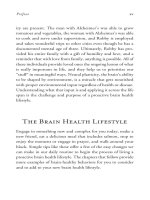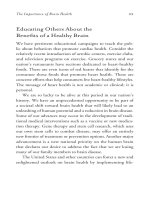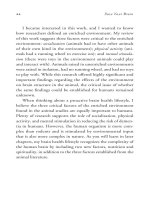Save Your Brain: The 5 Things You Must Do to Keep Your Mind Young and Sharp_11 docx
Bạn đang xem bản rút gọn của tài liệu. Xem và tải ngay bản đầy đủ của tài liệu tại đây (243.14 KB, 15 trang )
Save Your Brain134
Now, slowly release your fi ngers, extending them, and notice
how the tension leaves your fi ngers. The more relaxed feeling
achieved by letting the fi st go and extending your fi ngers is an
example of how you can focus on any muscle group in your
body to release stress. Tightening and releasing muscles all over
your body (head to toe) two to three times a day will provide
much-needed relief from tension. At the end of the exercise,
you will notice that energy in the form of stress has left you,
and you will feel better!
Brain Health Tip
Practice progressive muscle relaxation and deep breathing exercises two
to three times daily. Turning inward will help your brain escape temporar-
ily the stress-fi lled and unenriched environments of life.
Spirituality at Home
You will benefi t from slowing down, relaxation, and developing
inner balance, and practicing at home would probably be your
best bet. Like everyone else, you and your family are hurried
and many times neglect to take a moment of refl ection. Make
your home an escape where you can engage with refl ective med-
itation and spirituality. Chronic stress builds up from a hurried
environment and can do structural and functional damage to
our brains. Spirituality offers some practical methods to slow
down. Here are some ways you can explore spirituality at home
to promote brain health:
Critical Area 4: Spirituality 135
• Create a space for yourself at home, either designating a
specifi c room or a specifi c area of your home offi ce or liv-
ing room as a place to meditate, pray, or practice breathing
and progressive muscle relaxation. Allotting a specifi c area
makes you more likely to practice refl ective meditation and
spirituality on a daily basis.
• Create a special time, whether it’s for ten or fi fteen min-
utes a day, to just sit in silence, away from technology,
with the goal of slowing down. You can take this block of
time to meditate, pray, or refl ect. You could even take a
walk in the park or around the block, go on a short bike
ride, or do some other quiet activity that puts your mind
at ease—encourage your family to do the same.
• Attend a formalized place of worship on a regular basis,
as this has been shown to be connected to happiness and
longevity. If this is not an activity that is possible for you
or your family, consider the other methods of spirituality
described in this chapter.
• Keep a box of cards that have meditative refl ections around
the house. The moment you begin to feel anxious or
stressed, stop and take a moment to relax and go through
some of the meditative refl ections.
Chronic stress can be damaging to the body and to the brain,
particularly to functions such as memory and mood. We know
that animals that are exposed to environments that are too stim-
ulating experience slowed brain development. We also know
that relaxation, slowing down, enjoying the moment, gaining
homeostasis, and engaging in formal and informal spirituality
Save Your Brain136
can lead to better general health and to brain health. Now that
you have some ideas for how you and your family can be spiri-
tual at home, it is important to also apply some of these tips
at work.
Spirituality in the Workplace
Every day you’re encouraged to do more to meet deadlines,
produce more, be more innovative—to be better, faster, and
stronger. It’s no wonder that the workforce is stressed and
burned out. This chronic stress, as I’ve mentioned earlier, is
detrimental to brain health, which is why now, more than ever,
we need to cultivate and create a brain-health-conscious culture
at work. You need to slow down and achieve inner balance—
even at work. Here are some practical ways to boost spirituality
at work:
• Engage in a quiet moment of daily prayer, meditation, and
simply closing your eyes when you’re commuting on your
way to work.
• Consider your lunch break as a time for you to either med-
itate or focus on refl ective spirituality—fi nd a quiet place
away from your desk and away from distractions. Giving
yourself thirty minutes each day to slow down and turn
to a spiritual activity will help rid your body of stress and
enable more effi cient brain function.
Critical Area 4: Spirituality 137
• Ask your human resources department if there are wellness
programs available, such as yoga or meditation classes that
offer corporate discounts.
• Engage in two or three fi ve-minute periods throughout the
day to engage in breathing exercises or muscle relaxation
techniques.
Promote Spirituality in Other
Areas of Your Life
It is really important for us to achieve homeostasis and balance,
particularly when we are confronted by such a rapid pace in
daily life. We have already discussed why spirituality is impor-
tant to general and brain health and how we can express our
spirituality at home and in the workplace. We can now consider
how we might apply spiritual behaviors in other settings that we
encounter as part of our normal lives. Spirituality provides all of
us techniques to slow down, turn inward, reduce the negative
physiological effects of chronic stress on our brain and body,
and help us to generate a more pleasing sense of balance and
homeostasis. Consider these additional tips and ideas for you to
express formal and informal spirituality in your daily life:
• Visit your favorite setting two to three times a week. This
might be a community park, lake, beach, mountain base,
river, or anywhere you feel at peace. Enjoy the beauty of
your environment—taking in the beauty of your surround-
ings can also be considered spiritual.
Save Your Brain138
• Get outside or simply remove your body and mind from
the tasks that are in front of you. Everything else will be
waiting for you when you return.
•
Sometimes music helps when you retreat to your spiritual
place. I like to download sounds of the ocean and waves
and listen to soothing music while I pray or meditate.
It is both important for us to change our lifestyles and learn
to slow down to promote brain health. Engaging in spiritual-
ity is a great way to stop, refl ect, meditate, and relax to take
a respite from our hurried lifestyles. While that is easily said
and understood, it is also very diffi cult to change behavior. In
order for you to achieve success with the spiritual domain as
part of the brain health lifestyle, you must fi rst identify the
stress in your life, where you experience stress in your body,
and how you deal with this stress now. To deal with your stress
effectively, consider the tips provided you in this chapter and
encourage your family do the same.
Critical Area 4: Spirituality 139
Tips to Promote Brain Health: Quick Review
• Learn relaxation procedures that include rhythmic breathing and pro-
gressive muscle relaxation.
• Forms of spirituality such as meditation, relaxation procedures, enjoy-
ing nature, yoga, and tai chi can help you turn inward and remove
stress from your body.
• Give yourself thirty minutes a day every day for your own quiet time
to be refl ective.
• Keep guided meditation cards or prayers at your fi ngertips for
moments when you feel entirely overwhelmed. Keep a deck of these
cards at home or in your offi ce.
• Create a special area for yourself at home specifi cally for meditation
or prayer.
• Get a good night’s sleep so that you feel rested in the morning.
This page intentionally left blank
141
9
Critical Area 5:
Nutrition
What we eat shapes the structure and function of our brain, including
thoughts and emotions.
7
O
ne of the most popular and studied areas of health care
today is that of nutrition and how what we eat relates
to our general well-being. This is particularly true for diet and
the human brain. Indeed, an entire new fi eld of study known
as nutritional neurosciences has evolved to address this grow-
ing interest. Today we believe that the foods we consume not
only affect our general body but can also affect our emotion,
thoughts, energy level, and even our ability to have a healthy
brain later in life. In this chapter, I’ll show you how you can eat
for the benefi t of a healthier brain. Later on I’ll also give you
some great recipes so you can easily incorporate nutrition into
your healthy brain lifestyle.
Save Your Brain142
How the Food You Eat Affects
Brain Health
As humans, we’ve been shaped to some degree by the types of
foods we have eaten. Our bodies and behavior will be shaped
literally by the types of food, good or bad, that we consume,
and this has been the case for thousands of years. Nearly every-
thing we put in our mouths is converted into glucose and
absorbed into the cells of our body for energy. As the brain is
most demanding and will take nearly 25 percent of the energy
from each swallow, there is a direct relationship to what we eat
and the structural and functional integrity of our brain.
Perhaps as important is the fact that the brain consists of
nearly 60 percent fat and may actually be the fattest part of
our bodies. The fat in our brain is really a lipid substance that
insulates our nerve tracts and cells and helps the brain process
information rapidly. When the fat breaks down, we tend not
to think effi ciently, we may experience attention problems, and
we may suffer emotional changes such as sadness. It is impor-
tant for everyone to understand that by keeping a robust level
of fat in our brains, we are actually helping to shape our brains
toward health.
Our diet provides us a direct pathway to build up the fat
in our brains. We have access to foods that contain good fats,
those typically found in fatty fi sh, such as salmon, herring,
mackerel, and sardines. Some unsalted nuts, such as almonds
and walnuts, also have good, or healthy, fats. These types of
healthy fats help the brain function more effi ciently and are
Critical Area 5: Nutrition 143
characterized as omega-3 fatty acids. Bad, or unhealthy, fats are
found in foods high in trans-fatty acids or saturated fats. These
unhealthy fats can do damage to the brain over time and are
commonly found in fast foods and fried foods, among others.
We need to try and achieve as high a ratio of healthy fats to
unhealthy fats as we can. Unfortunately, our current ratios, as
a nation, are quite poor.
Today a typical person, particularly those who live in west-
ernized cultures, will consume nearly fi fteen times more bad
fat than good fat. This is a signifi cantly unhealthy balance that
increases the risk of brain dysfunction from a variety of dis-
orders, such as cerebrovascular disease, cardiovascular disease,
obesity, and diabetes. Intake of bad fats, including trans-fatty
acids, saturated fats, and omega-6 fatty acids, can lead to a
breakdown in the plasticity of brain cells, creating less effi cient
information processing.
The signifi cant rise in obesity and diabetes during the past
twenty-fi ve years reveals how high-fat and processed foods
have literally changed our appearance and increased our health
problems. Unhealthy foods have also contributed to increases
in mental illness, sleep disorders, dementia, stroke, and even
attention defi cit disorder. If this is true and some foods can
actually alter our neurochemistry toward dysfunction and dis-
ease, other foods can also promote brain health. It becomes
important to identify and adopt a specifi c diet, not just for our
well-being but also for brain health!
Save Your Brain144
Ancestral Diets: Eating Fish
Nurtures the Brain
According to some, our earliest ancestors followed a simple diet
that
did promote brain health. The diet included leaves, plants,
berries, nuts, beans, fi sh, and lean game. Estimates indicate that
our prehistoric ancestors consumed one good fat for every bad
fat, an extremely healthy balance of fat intake. Remember, your
brain is 60 percent fat, and this lipid needs to be nurtured by
consumption of healthy fats for proper and effi cient processing
of information.
Did you know that human civilizations had their greatest
periods of development when living and working near water?
One reason may be that the water provided for a greater con-
sumption of fatty fi sh, which contains the good fat that nur-
tures the brain and permits the brain to be at its functional
and intellectual best. Consider all the great achievements of our
early ancestors who lived near the Euphrates and Nile Rivers
and the Mediterranean Sea. Consumption of proper fats typi-
cally found in fatty fi sh promotes fl exibility in brain cells and
effi cient transmission of information between cells. It helps the
cell membrane maintain a type of elasticity rather than a rigid
and fi xed state that will reduce information processing. Once
again, the brain is highly lipid, with nearly 60 percent of the
brain composed of fat. Foods that help to maintain the healthy
levels of lipid and fat in the brain are enormously helpful to the
structural and functional integrity of the brain.
Critical Area 5: Nutrition 145
From the Agricultural Revolution to
Processed Foods
As we evolved, the agricultural revolution brought diets con-
taining milk, eggs, cheese, and meat. These foods are not con-
sidered brain-healthy even though they have become standard
in most diets. With the beginning of the industrial and now
information revolution, diets have included new foods known
as processed foods. The entire fast-food industry was born,
and today it provides a major part of millions of persons’ daily
nutritional intake. Processed foods are unhealthy—fi lled with
bad fats, salt, sugars, and calories. Processed foods are a major
contributor to the risk of obesity, diabetes, and a myriad of
disorders that can result in degeneration and dysfunction of the
human brain. Obesity and diabetes alone are major threats to
the function of the brain, correlate with stroke and dementia,
and now occur in childhood at unprecedented rates relative to
any other time in our history.
Antioxidants and Brain Health
In addition to the brain-healthy effects of omega-3s in such
foods as fatty fi sh, antioxidants have been shown to be wonder-
ful for our general health and for brain health. Remember when
you were a child and your parents and grandparents told you
to “eat your vegetables”? It turns out they were pretty smart,
because it is precisely the fruits and vegetables that have high
antioxidant properties and are very healthy for our brains.
Save Your Brain146
An antioxidant is a type of “broom” that helps to sweep the
toxins out of our bodies. Believe it or not, our bodies are fi lled
with toxins known as “free radicals” that can cause or lead to
many disorders from cataracts, arthritis, cancer, heart disease,
osteoporosis, and even dementia. It is paradoxical, because free
radicals begin in the oxygen molecules that we need to survive.
It seems that the oxygen molecule becomes unstable electrically
and breaks away to bond with another cell in the body. This
“free” roaming and binding of the cell causes the damage “radi-
cal” that can lead to the conditions just mentioned. We believe
free radicals develop from pollution, chronic stress, too much
wear and tear on the body, toxins, and even poor diet. As our
bodies do not produce many antioxidants as we get older, we
need to supplement our levels through the diet. This is where
fruits and vegetables become critical, because they are fi lled
with antioxidants that can help to fi ght against free radicals.
It is vital to appreciate the importance of food and nutrition
in our lives. Food has a biological and a social importance to
us. We can work to increase the amount of healthy foods and
also have some fun. Food provides us a great opportunity to
socialize, network, recreate, and enjoy intimate moments. Food
is also a pleasure and really needs to be enjoyed. I have asked
Kathy Rusk, a registered dietician, to help with the next sec-
tion of this chapter. Kathy will help us to learn more about the
specifi c foods that are good for our brain, and at the end of the
chapter, she even provides us with some brain-healthy recipes
that we can try in our own kitchens. For more information and
nutritional tips, visit her website: nutritiondynamicsnw.com.
Critical Area 5: Nutrition 147
Healthy Brain Diet
A healthy human brain relies on having a mixture of nutrients
from a variety of foods. Macronutrients (carbohydrates, pro-
tein, and fats) and micronutrients (vitamins and minerals) are
vital for the human brain to function at all, and preferably well,
throughout life. However, we know now that specifi c nutrients
within these categories have a greater effect on the functioning
of the brain than others. As we’ve seen, some fats should be
avoided, others lowered, and some even increased.
Scientists now know that there are hundreds if not thou-
sands of micronutrients in specifi c foods that are high in the
particular nutrients that the brain needs. In order to have a
well-functioning brain, consume a variety of foods that provide
the nutrients that a healthy brain needs. No one food is magi-
cally going to improve the brain’s function; instead there are
many foods to include in a typical day and week. Consuming
nutrients in their natural form is the safest and surest way to
meet nutritional needs for a healthy brain.
Carbohydrates yield energy that provides fuel for the brain
for short-term memory and basic thinking skills. Therefore,
as an energy source, any carbohydrate is effective. However, it
behooves one to consume them in foods that have a low glyce-
mic index, those that contain low levels of fructose, and foods
that carry with them benefi cial nutrients.
Protein makes up neurotransmitters that allow the brain
cells to communicate; they are the building blocks of the brain’s
network. Protein is also a component of the myelin sheath that
Save Your Brain148
covers neurons. Complete proteins are essential for these com-
ponents. The human body is able to synthesize all the proteins
needed from nitrogen-containing foodstuff (amino acids) con-
sumed in various foods, as long as the essential amino acids,
those the body cannot produce by itself, are consumed.
Fats make up 70 percent of the protective myelin sheath that
covers the neurons responsible for the communication within
the brain; DHA (docosahexaenoic acid) is the specifi c omega-3
fatty acid that is especially important for this myelin sheath,
and thus for brain health. Look ahead to the “Fats” section for
foods high in DHA.
Micronutrients contain antioxidants that act in extraordi-
nary synergy with each other to neutralize the free radicals that
are produced in the brain that could damage the brain cells
faster than they can be repaired. Antioxidants that benefi t the
brain specifi cally are in a variety of food.
Carbohydrates
Carbohydrates have been categorized into a glycemic index,
which is a tool to quantify the amount that will cause blood
sugars to rise. High blood-sugar levels, if not reduced by a nor-
mal insulin response, are harmful to some organs, including
the brain. In general, the more processed a carbohydrate is, the
more quickly blood sugar will rise. However, the glycemic load
in one food item can vary depending on its ripeness, how long
it is cooked, the actual temperature of the food, the acidity of
the specifi c food at that time and what it is eaten with, and the









